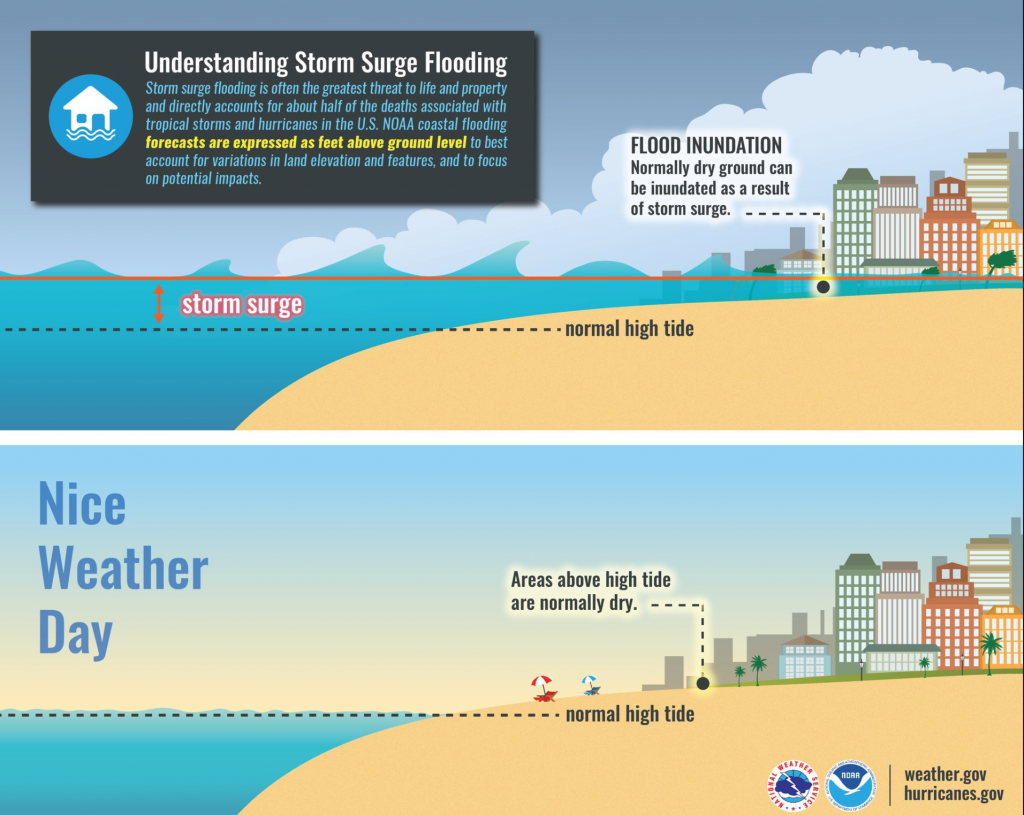Hurricanes & Tropical Storms
Hurricanes and Tropical Storms are massive storm systems that form over warm ocean waters and move toward land. Potential threats include powerful winds, heavy rainfall, storm surges, coastal and inland flooding, rip currents, tornadoes, and landslides.
The Atlantic hurricane season lasts from June 1 to November 30, with the peak season from mid-August to late October.
PREPARING YOUR FAMILY
- Update or build your disaster supply kit.
- Make a family emergency communication plan.
- Sign up for emergency alerts.
PREPARING YOUR HOME
- Hurricane winds can cause trees and branches to fall, so before hurricane season trim or remove damaged trees and limbs to keep you and your property safe.
- Secure loose rain gutters and downspouts and clear any clogged areas or debris to prevent water damage to your property.
- Reduce property damage by retrofitting your home to secure and reinforce the roof, windows and doors, including the garage doors.
- If you purchase a portable generator, have a licensed electrician install the correct transfer switch for your home. NEVER try to power the house wiring by plugging a generator into a wall outlet.
- Consider building a FEMA safe room or ICC 500 storm shelter designed for protection from high-winds and in locations above flooding levels.
- Review or purchase a homeowner's insurance policy. If you live in an area that is prone to flooding, consider purchasing flood insurance.
- Take photos of all your valuables and the condition of your house inside and out, including the roof. Store the photos on a flash drive or a secure online file hosting service along with copies of your important documents.
A STORM IS ON THE WAY; WHAT DO I DO?
- Restock your emergency preparedness kit. Include food and water sufficient for at least three days, medications, a flashlight, batteries, cash, and first aid supplies.
- Plan how to communicate with family members if you lose power. For example, you can call, text, email or use social media. Remember that during disasters, sending text messages is usually reliable and faster than making phone calls because phone lines are often overloaded.
- Keep your car in good working condition, and keep the gas tank full; stock your vehicle with emergency supplies and a change of clothes.
- Monitor the County's Emergency Information Portal.
- If you are asked to evacuate, local officials will tell you which routes to use and what shelters or evacuation facilities are available. Prince William County does not have pre-designated coastal hurricane evacuation zones like other parts of the Commonwealth, but residents who live in flood-prone or low-lying areas, particularly along the Potomac and Occoquan Rivers, should be prepared to move to higher ground during a major hurricane.
- If you are not in an area that is advised to evacuate, be sure you have adequate supplies in case you lose power and water for several days and you are not able to leave your home or neighborhood due to flooding or blocked roads.
FLOODING AND STORM SURGE HAZARDS IN PWC
In other parts of Virginia, the Virginia Department of Emergency Management has established designated evacuation zones, identified as "Zone A - D," primarily for Hampton Roads, the Northern Neck, and the Eastern Shore. While these zone A-D designations are not applicable in our area, Prince William County still has the potential to experience storm surge along the Potomac River, along with inland fresh water flooding of area waterways.
To see if your property is in a designated Federal Emergency Management Agency (FEMA) floodplain or a Virginia Storm Surge Zone, click here to view the interactive lookup tool.
To learn more about floodplains, click here.
To learn about Storm Surge, please review the graphic below:
